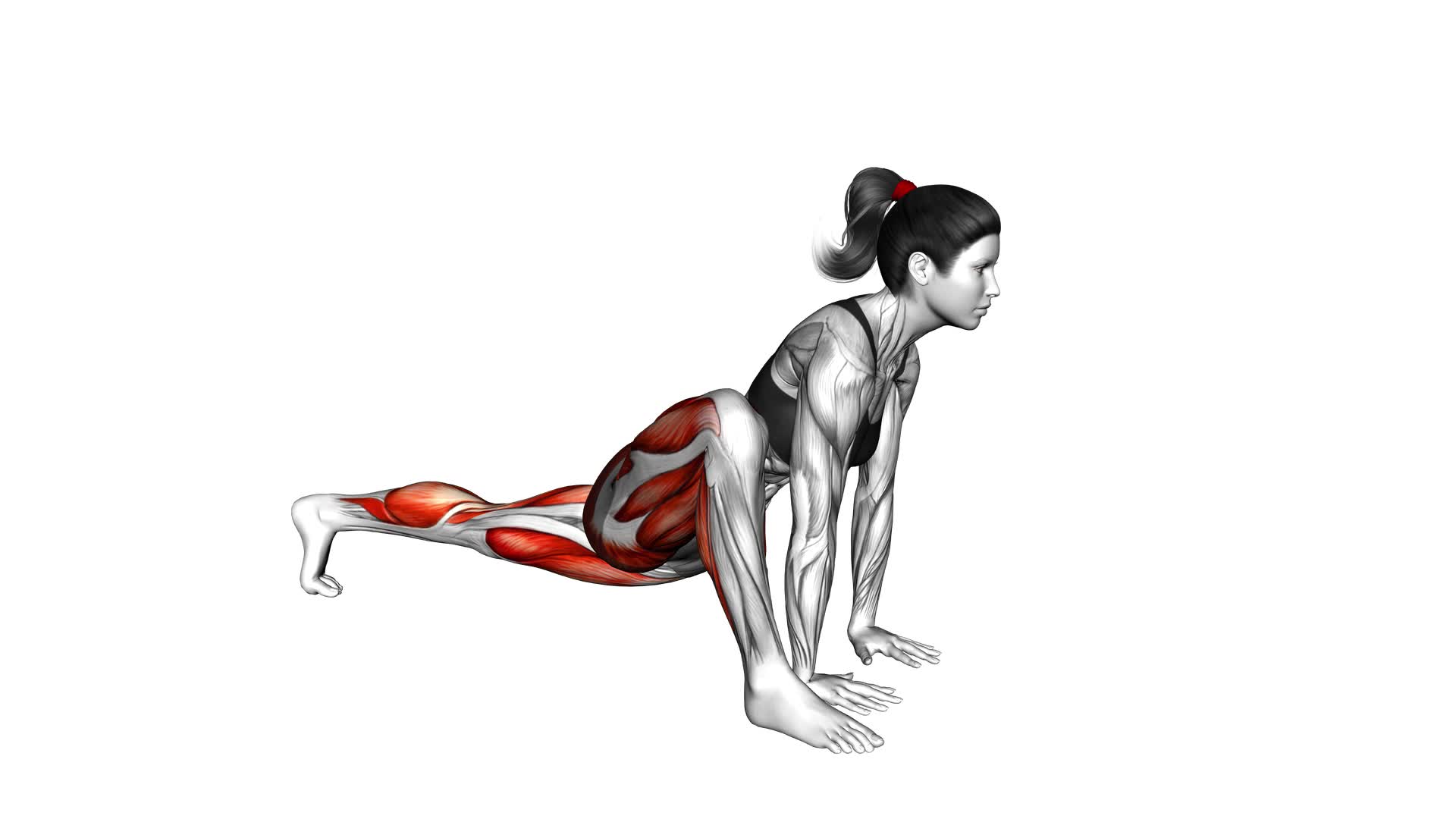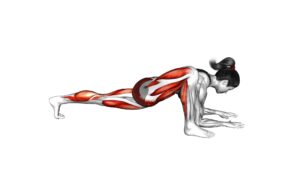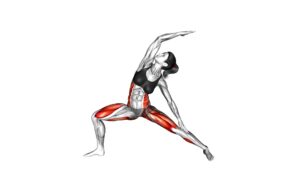Lizard Pose (VERSION 2) (female) – Video Exercise Guide & Tips

Get ready to level up your lizard pose with this video exercise guide! In this version, specifically designed for females, you'll discover the benefits, proper alignment, modifications, and tips to deepen your practice.
Watch This Exercise Video
Learn how to avoid common mistakes and understand the precautions and contraindications. Whether you're a beginner or an experienced yogi, this guide will help you perfect your lizard pose and take your practice to the next level.
Let's get started!
Key Takeaways
- Lizard Pose (VERSION 2) targets multiple muscle groups including hips, groin, hamstrings, and hip flexors.
- It increases overall flexibility and range of motion.
- The pose strengthens the core and improves balance.
- Lizard Pose (VERSION 2) relieves tension and tightness in the hips and lower back.
Benefits of Lizard Pose (VERSION 2)
Experience the numerous benefits of Lizard Pose (VERSION 2) as you engage your muscles and improve flexibility. This variation of Lizard Pose offers a range of advantages for your mind and body.
One of the key benefits is that it targets multiple muscle groups, including the hips, groin, hamstrings, and hip flexors. By stretching these areas, you can increase your overall flexibility and range of motion. Additionally, Lizard Pose (VERSION 2) helps to strengthen your core and improve balance.
Another benefit of this pose is that it can help to relieve tension and tightness in the hips and lower back. As you sink into the pose, you may feel a gentle release of any pent-up stress or discomfort.
Furthermore, Lizard Pose (VERSION 2) offers variations that can be modified to suit your needs and level of flexibility. You can choose to keep your back knee on the ground or lift it for a deeper stretch. You can also experiment with different arm positions to further engage your muscles.
In the next section, we'll explore the proper alignment for Lizard Pose (VERSION 2), ensuring that you get the most out of this pose while avoiding any potential strain or injury.
Proper Alignment for Lizard Pose (VERSION 2)
To ensure proper alignment in Lizard Pose (VERSION 2), start by placing your hands on the ground shoulder-width apart. From there, step your right foot forward between your hands and lower your left knee to the ground. Keep your right knee directly above your ankle, forming a 90-degree angle. Now, extend your left leg straight back, pressing the top of your foot into the mat.
To deepen the stretch, you can lower your forearms to the ground, keeping them parallel to each other. This modification allows for a greater opening in the hips and groin. If you're looking for an additional challenge, you can lift your back knee off the ground, coming onto the ball of your left foot. This variation adds more strength and balance to the pose.
Remember to engage your core muscles and keep your spine long throughout the pose. Avoid collapsing into your lower back or sinking into your hips. By maintaining proper alignment, you can ensure a safe and effective practice.
Experiment with these lizard pose modifications and variations to find what works best for your body. As always, listen to your body and modify the pose as needed to avoid any discomfort or strain. Enjoy your lizard pose practice!
Modifications for Lizard Pose (VERSION 2)
Enhance your lizard pose practice with these modifications. Whether you prefer to practice standing or seated, there are modifications available for everyone.
For standing modifications, if you have difficulty getting into the full expression of lizard pose, you can use props such as blocks or a chair for support. Place your hands on the props at a comfortable height and step one foot back into a lunge position. This will help to alleviate any strain on your hips and allow you to focus on the stretch in your front leg.
If you prefer a seated variation, you can modify lizard pose by sitting on a folded blanket or bolster. This will provide extra support and elevate your hips, making it easier to maintain the pose for a longer period of time. From a seated position, extend one leg forward and bend the other knee, placing the foot on the inside of your extended leg. Lean forward, keeping your spine long, and breathe deeply into the stretch.
Tips for Deepening Your Lizard Pose (VERSION 2)
To deepen your lizard pose (VERSION 2), incorporate these tips for a more challenging and effective practice.
One way to deepen your lizard pose is by modifying the position of your hands. Instead of placing your hands on the ground, you can try placing them on blocks or using yoga straps to extend your reach. This will allow for a deeper stretch in the hips and groin.
Another modification you can try is to lift your back knee off the ground. This variation will intensify the stretch in the front leg and increase the strength and stability required to hold the pose.
Additionally, you can experiment with different variations of the lizard pose. For example, you can add a twist by placing one hand on the ground and reaching the other hand towards the ceiling. This variation won't only deepen the stretch in the hips but also engage the core and improve spine mobility.
Remember to listen to your body and only go as far as feels comfortable. By incorporating these lizard pose modifications and variations, you can take your practice to the next level and experience the full benefits of this powerful pose.
Common Mistakes to Avoid in Lizard Pose (VERSION 2)
When practicing Lizard Pose (VERSION 2), it's important to be aware of common mistakes to avoid in order to maintain proper form and prevent injury. Here are some common mistakes to watch out for:
- Dropping the hips too low: While it's important to sink into the pose, avoid letting your hips drop too low, as this can strain the knees and lower back. Keep a slight bend in the front knee and engage your core to support your body.
- Collapsing the chest: Maintain an open chest throughout the pose by drawing your shoulder blades together and down your back. This helps to keep your spine aligned and prevents rounding of the upper back.
- Forgetting to engage the back leg: While the focus is on the front leg, don't neglect the engagement of the back leg. Press the back foot into the mat and actively lengthen through the back leg to create stability and balance.
- Neglecting variations and modifications: Lizard Pose (VERSION 2) can be challenging for some practitioners. Don't be afraid to modify the pose by using props like blocks or blankets to support the hands or knees. You can also try the pose with a bent back knee to lessen the intensity.
- Holding the breath: Remember to breathe deeply and continuously throughout the pose. Holding the breath can create tension in the body and limit your ability to relax and deepen into the pose.
By avoiding these common mistakes and practicing with awareness, you can reap the full benefits of Lizard Pose (VERSION 2) while keeping your body safe and injury-free.
Now, let's move on to discussing the precautions and contraindications for Lizard Pose (VERSION 2).
Precautions and Contraindications for Lizard Pose (VERSION 2)
To ensure a safe and effective practice of Lizard Pose (VERSION 2), it's important for you to be aware of the precautions and contraindications associated with this pose. By taking these precautions, you can prevent injuries and make the most out of your yoga practice.
Firstly, if you have any existing injuries or medical conditions, it's crucial to consult with your healthcare provider before attempting Lizard Pose (VERSION 2). They can provide you with personalized guidance and ensure that this pose is suitable for your body.
Additionally, if you experience any pain or discomfort during the pose, it's essential to listen to your body and modify or come out of the pose if needed. Pushing through pain can lead to further injuries.
Moreover, if you have any issues with your hips, knees, or ankles, it's advisable to approach Lizard Pose (VERSION 2) with caution. This pose places a significant amount of strain on these areas, so it's important to practice with awareness and only go as far as feels comfortable for you.
If Lizard Pose (VERSION 2) isn't suitable for you, there are alternative poses that can provide similar benefits. Poses like Low Lunge or Pigeon Pose can help you stretch the hips and groin while offering a more accessible variation.
Frequently Asked Questions
How Long Should I Hold the Lizard Pose (Version 2) for Maximum Benefits?
To get maximum benefits from the Lizard Pose (version 2), you should hold it for at least 30 seconds. This will help improve your hip mobility and strength.
However, depending on your fitness level, you can modify the pose to suit your needs. Beginners can start by bending their back knee or using props for support.
Intermediate and advanced practitioners can deepen the stretch by straightening the back leg or lifting the back foot.
Can Lizard Pose (Version 2) Help With Lower Back Pain?
Lizard pose (version 2) is known for its benefits in relieving lower back pain. This pose targets the hips and groin, improving their flexibility. Beginners can modify the pose by using props or reducing the intensity. Pregnant individuals can also try variations that suit their needs.
To experience maximum benefits, it's recommended to hold the pose for an optimal duration. Incorporating lizard pose (version 2) into your routine can help alleviate lower back pain and increase overall flexibility.
Is It Safe to Practice Lizard Pose (Version 2) During Pregnancy?
During pregnancy, it's important to modify your yoga practice to ensure safety for both you and your baby.
When it comes to lizard pose (version 2), there are a few precautions and considerations to keep in mind.
To accommodate your growing belly, you can widen your stance and use blocks for support. Avoid deep stretches and listen to your body, stopping if you feel any discomfort.
Always consult with your healthcare provider before starting or continuing any exercise routine during pregnancy.
Are There Any Variations of Lizard Pose (Version 2) for Beginners?
If you're new to lizard pose (version 2), there are a few variations and modifications you can try to make it more accessible.
Beginners can start by keeping their back knee on the ground for added stability. You can also use blocks or props to support your upper body if reaching the ground is challenging.
Remember to listen to your body and take it slowly, gradually increasing your flexibility and strength over time.
Can Lizard Pose (Version 2) Improve Flexibility in the Hips and Groin Area?
Lizard Pose (Version 2) is a great way to improve flexibility in your hips and groin area. By incorporating this pose into your routine, you can increase hip flexibility and enhance your range of motion.
The deep stretch provided by Lizard Pose (Version 2) targets the muscles in your hips and groin, helping to release tension and increase flexibility.
Conclusion
In conclusion, practicing Lizard Pose (Version 2) offers numerous benefits including improved hip flexibility, increased strength in the legs and core, and a release of tension in the hips and groin.
By following proper alignment and making modifications as needed, you can safely deepen your pose and avoid common mistakes.
However, it's important to listen to your body and consult with a healthcare professional if you have any concerns or existing injuries.
Enjoy the benefits of Lizard Pose and have a fulfilling yoga practice!

Author
Years ago, the spark of my life’s passion ignited in my mind the moment I stepped into the local gym for the first time. The inaugural bead of perspiration, the initial endeavor, the very first surge of endorphins, and a sense of pride that washed over me post-workout marked the beginning of my deep-seated interest in strength sports, fitness, and sports nutrition. This very curiosity blossomed rapidly into a profound fascination, propelling me to earn a Master’s degree in Physical Education from the Academy of Physical Education in Krakow, followed by a Sports Manager diploma from the Jagiellonian University. My journey of growth led me to gain more specialized qualifications, such as being a certified personal trainer with a focus on sports dietetics, a lifeguard, and an instructor for wellness and corrective gymnastics. Theoretical knowledge paired seamlessly with practical experience, reinforcing my belief that the transformation of individuals under my guidance was also a reflection of my personal growth. This belief holds true even today. Each day, I strive to push the boundaries and explore new realms. These realms gently elevate me to greater heights. The unique combination of passion for my field and the continuous quest for growth fuels my drive to break new ground.







